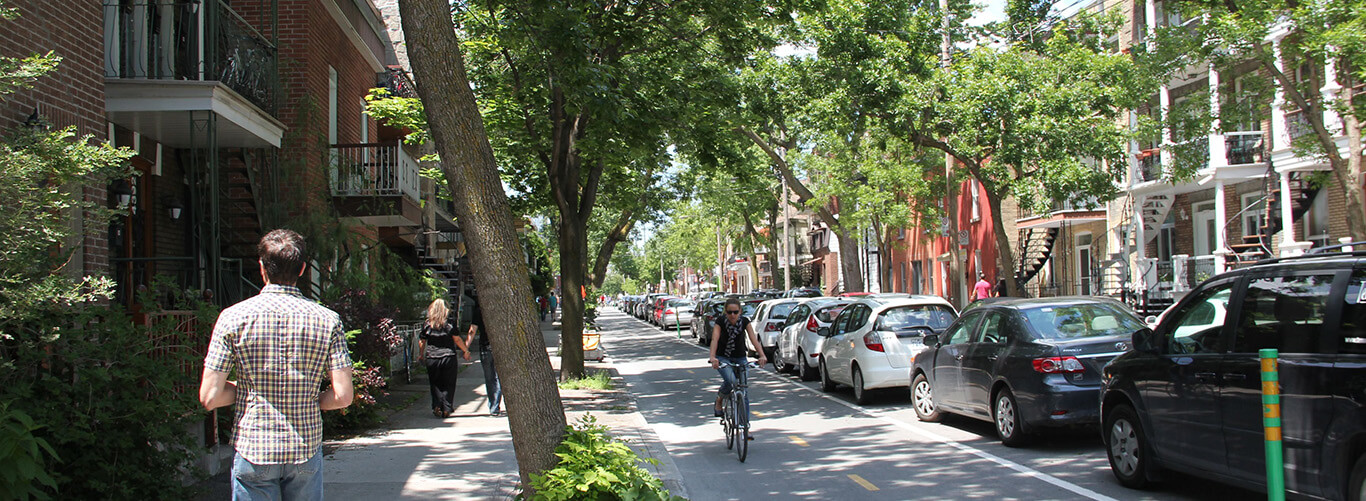Most people understand that a reduction in driving could have a measurable impact on slowing the process of climate change by reducing harmful tailpipe emissions, but how do you convince enough people to refrain from driving?

Parking-protected bike lanes in Montreal’s Plateau neighborhood, which has one of the highest cycling mode shares in North America. Photo by Karen
New research presented by scientists at McGill University suggests that the construction of safe bike infrastructure could significantly reduce vehicle tailpipe emissions by offering potential motorists an attractive alternative to getting in their cars. Basically, it’s the “if you build it, they will come” philosophy many advocates lean on to champion bike infrastructure, backed up by scientists.
To arrive at their findings, the Canadian-based team of researchers looked at how commuter cycling modal share has evolved with changes in the built environment in Montreal, QC. They looked at automobile and bicycle trip information from origin–destination surveys for the years 1998, 2003 and 2008, and, after controlling for other factors in the built environment, determined how the construction of new bike infrastructure instigated shifts from automobile mode share toward cycling mode share.
“A statistically significant association is also found between the index of bicycle infrastructure accessibility and bike mode choice,” says the study. “An increase of 10% in the accessibility index results in a 3.7% increase in the ridership.”
The researchers then analyzed the specific reduction in Greenhouse Gas emissions (GHG) that was produced by the construction of dedicated bike infrastructure and subsequent reduction in driving, noting, “A reduction of close to 2% in GHG emissions is observed for an increase of 7% in the length of the bicycle network.”
If that figure doesn’t seem significant, consider that the same reduction in emissions for Montreal’s public transit system would require the city’s entire fleet of buses to converted to hybrid, and its entire commuter rail line to be electrified. That undertaking would be not be cheap.
A single 40-foot hybrid bus costs CAN $450,000. For the same amount of dough, you can build approximately 3.5 miles (5.5 km) of new bike lanes. When you consider that the Montreal’s public transportation service runs multiple buses on over 200 routes each day, you have a pretty strong economic case to prioritize building those bike lanes.
While critics point out that the study is too limited in its scope – after all it could just be some other element specific to Montreal that lends itself to a strong cycling culture – the finding is corroborated by numerous other studies which link increased bicycle infrastructure to increased ridership.
A 2014 study undertaken by researchers in Portland determined that the construction of new bike lanes led to an increase in ridership anywhere from 21 to 171 percent in different neighborhoods, with about 10 percent of that increase drawn from other modes. Similarly, a 2015 survey conducted by PeopleForBikes determined that 54 percent of Americans spoken to would like to bike more, but fear of getting hit by a car holds them back. A further 46 percent agreed they would bike more if there was a physical barrier separating them from automobile traffic.
So building bike lanes is a effective method to increase ridership, and increasing ridership is an effective method to combat climate change. What are we waiting for?
Get your FREE copy of our new guide: Momentum Mag's Urban Cycling Guide
In our latest free guide, we share a few tips and tricks for anyone new to urban cycling who is looking to get started. We discuss the latests numbers regarding safety and cycling as well as go over a few rules of the road that every cyclist should know.
Thank you for your submission. Your free guide has been sent to the email address you provided.










Well no kidding~ let’s stop overthinking it, and just get it done, is what I say. Power to the people!
Comments are closed.